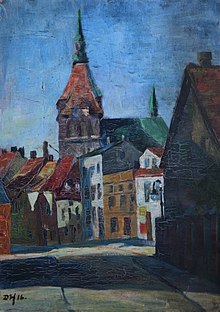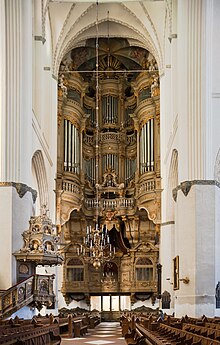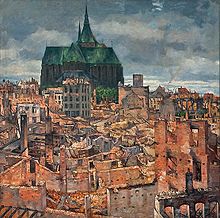
St. Mary's Church, or formally the Basilica of the Assumption of the Blessed Virgin Mary, is a Brick Gothic Catholic church located in central Gdańsk, Poland. With its volume between 185,000 m3 and 190,000 m3 it is currently one of the two or three largest brick churches in the world. Only San Petronio Basilica in Bologna, comprising 258,000 m3 is larger, Munich Frauenkirche and Ulm Minster also comprise 185,000 to 190,000 m3.

The Lübeck Marienkirche is a medieval basilica in the city centre of Lübeck, Germany. Built between 1265 and 1352, the church is located on the highest point of Lübeck's old town island within the Hanseatic merchants' quarter, which extends uphill from the warehouses on the River Trave to the church. As the main parish church of the citizens and the city council of Lübeck, it was built close to the town hall and the market.

St. Peter's Church, in German Petrikirche, was built in the 13th century and is the oldest of three town churches found in the Hanseatic city of Rostock, in northern Germany. The other two are St. Mary's Church (Marienkirche) and St. Nicholas (Nikolaikirche). A fourth, St. Jakobi, was heavily damaged during the Second World War and subsequently demolished.

Erfurt Cathedral, also known as St Mary's Cathedral, is the largest and oldest church building in the Thuringian city of Erfurt, central Germany. It is the episcopal seat of the Roman Catholic Diocese of Erfurt. The cathedral was mainly built in the International Gothic style and is located on a hillside overlooking the main town square, directly next to St Severus' Church. As a unique architectural ensemble, both churches together form the city's landmark. Former German names include Marienkirche and Propsteikirche Beatae Mariae Virginis.

The Parish Church of Urtijëi located in the town of Urtijëi in Val Gardena in South Tyrol, Italy is dedicated to the Epiphany and to Saint Ulrich.

Heinrich Müller was a German devotional author, Protestant writer of hymns, a Lutheran minister and theologian and a professor at the University of Rostock from 1647 to 1650. He famously denounced the font, the pulpit, the confessional, and the altar as "the four dumb idols of the Lutheran Church". He died in Rostock, aged 43.

The Co-Cathedral of Saint Nicholas in Prešov is one of the oldest and most important churches in Slovakia. The external dimensions of the cathedral are 54.7m in length, 34.45m in width. The indoor nave is 16 m tall and tower reaches a height of 71 meters. The temple's design takes inspiration from the Late Gothic hall churches with three naves.

St. Mary's Church in Marienberg in the German state of Saxony is an Evangelical-Lutheran church in the southeast of the county of Erzgebirgskreis. It is the most recent of the three Ore Mountain Late Gothic hall churches.

Vester Egesborg Church is located in Næstved Municipality of Region Zealand, Denmark. It was built in 1250–1300, with the addition of the tower and vestry around 1500. The choir was rebuilt at the end of the 18th century. The pulpit and altarpiece were carved around the middle of the 17th century by Abel Schrøder in the auricular style. The wrought iron baptismal font from the 1670s bears the arms of Niels Trolle and Helle Rosenkrantz. A farmer, John Jensen, believed that a church should also have a ship, so with his wife, he bequeathed money for that purpose; Neptunus hangs from the ceiling of the church.

St Nicholas of Wismar was built from 1381 until 1487 as a church for sailors and fishermen. St Nicholas is one of the finest testaments to mediaeval brick architecture in northern Germany.
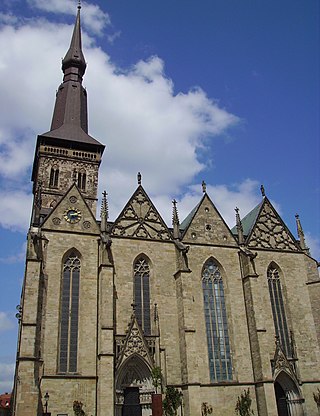
St. Marien is a Lutheran parish and market church in Osnabrück, Germany. It is one of the most artistically and historically significant buildings in the North German city. A previous Romanesque church was mentioned in records as early as 1177. However, the history of the church's construction began some time before it was first mentioned in writing. Archaeological traces suggest the existence of a predecessor building in the 10th century. Construction of the Gothic hall church which exists today started in the 13th century and was completed between 1430 and 1440.

Marienkirche is a church in Dortmund, North Rhine-Westphalia state, Germany, located in the inner city. Since the Reformation, it has been a Lutheran parish church of St. Marien. The church was destroyed in World War II, but rebuilt. It also serves as a concert venue for sacred music.

The Sankt-Gertraud-Kirche is a Protestant church in Frankfurt (Oder) in Germany. It is dedicated to Gertrude of Nivelles.
Nikolaus Hasse, sometimes spelled Nicolaus Hasse, was a German composer and organist of the Baroque period. Part of the Hasse family of musicians, he was the son of Peter Hasse. A longtime organist at St. Mary's Church, Rostock, he is best remembered today for his compositions of chamber music and sacred songs.

St. Kolumba was one of the largest parish churches in medieval Cologne, dating back to 980, and dedicated to Columba of Sens. The original Romanesque church was replaced by a Gothic church. Artworks in it included the Saint Columba Altarpiece by Rogier van der Weyden, and an altar by an anonymous artist.
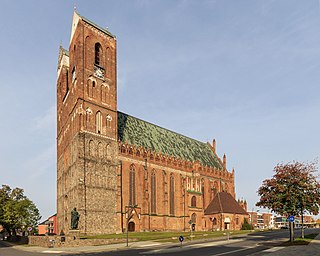
The Marienkirche in Prenzlau, Brandenburg, Germany, is the main Protestant parish church in the town, and is one of the most ornate churches of the Brick Gothic style in northern Germany. The church is a listed building.

The astronomical clock of St. Nicholas Church, Stralsund is a 14th century monumental astrolabe clock. It was probably damaged in the 16th century, and has not worked since then. It is the only clock of its kind to have been preserved almost entirely in its original condition. The clockwork and the indications have not been restored.
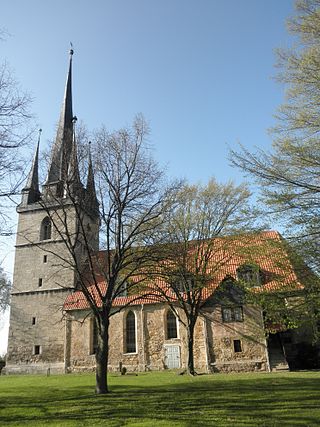
St Walpurgis' Church in the upper part of the village of Großengottern in Thuringia, Germany, is a Late Gothic church building dating from the 15th century. Today, it is a Lutheran parish church. St Walpurgis' Church is known for its large Baroque organ by the significant organ builder Tobias H. G. Trost.
The largest city in Mecklenburg-Vorpommern, Rostock is an important cultural center in Northern Germany. Records of the history of music in Rostock stretch back to the 13th century.

St. Peter's Church is a place of worship in Lübeck, Germany, that was first mentioned in 1170. Over the centuries, it was rebuilt several times until construction of the church was completed in the 15th century. During the Second World War, St. Petri suffered severe damage and the restoration was not completed until 1987. Since the furnishings could not be restored, only special services take place in the church. As a city church without a congregation, it is mainly used for cultural and religious events as well as art exhibitions.


